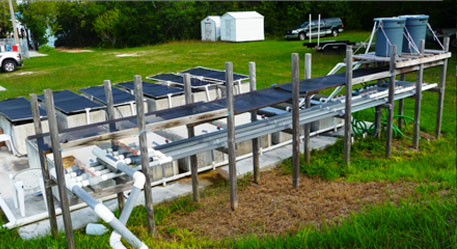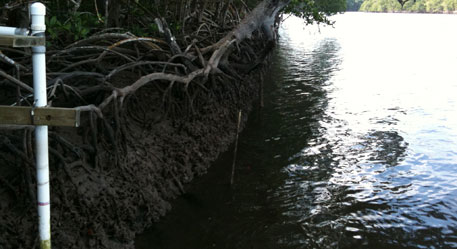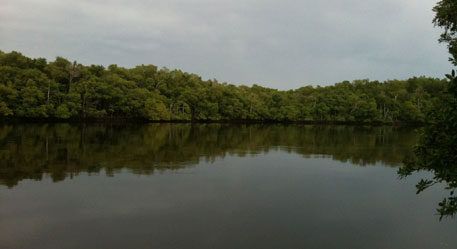
Manipulative experiments are being conducted at the newly renovated mesocosm facility at the Florida Bay Interagency Science Center in Key Largo, FL. The South Florida Water Management District developed the system and was instrumental in supporting its renovation.
Background
Peat soils are pervasive throughout the Everglades and represent a sensitive balance between organic matter production and decomposition. Peat soils are of critical importance to south Florida and the Greater Everglades Ecosystem because they represent an important carbon reservoir in the face of climate change, and peat accretion is crucial in maintaining wetland elevation relative to sea level. With sea level rising at ~3 mm y-1, these intertidal systems are being exposed to increased inundation and potentially higher salinity seawater. The interlinked biological processes that drive carbon cycling in Everglades coastal wetlands are poorly understood but critically important for predicting responses to sea-level rise, climate change, and outcomes of Everglades restoration.
Research Objectives
In conjunction with several co-investigators, we conducted manipulative experiments to determine the response of mangrove peat soils to both increased salinity and inundation in to understand the combined effects of sea-level rise and saltwater intrusion. Our overall objective for this work is to quantify the effects of multiple drivers on C cycling in Florida Coastal Everglades ecosystems. Results of this and future experiments will guide development of biogeochemical models leading to an understanding of the effects of sea-level rise and water management strategies on coastal peat stability. The work will be continued and expanded as part of FCE LTER III and other research.
 Mangrove peatlands on the southwest Florida coast experience semi-diurnal tides that exceed 1 m, a typical salinity range of 10-35 ppt, and soils that can be inundated over 50% yr-1. Average annual precipitation in 1600 mm yr-1. There is pronounced wet-dry season variability and hurricanes are a key driver of ecosystem development.
Mangrove peatlands on the southwest Florida coast experience semi-diurnal tides that exceed 1 m, a typical salinity range of 10-35 ppt, and soils that can be inundated over 50% yr-1. Average annual precipitation in 1600 mm yr-1. There is pronounced wet-dry season variability and hurricanes are a key driver of ecosystem development.
 Species that are prevalent in south Florida mangrove forests include red (Rhizophora mangle), black (Avicennia germinans), and white (Laguncularia racemosa) mangroves. Forests that experience more freshwater influence have typically higher species diversity. Peat depths exceed 5 m in some areas and canopy height can exceed 15 m.
Species that are prevalent in south Florida mangrove forests include red (Rhizophora mangle), black (Avicennia germinans), and white (Laguncularia racemosa) mangroves. Forests that experience more freshwater influence have typically higher species diversity. Peat depths exceed 5 m in some areas and canopy height can exceed 15 m.
Project Collaborators
Stephen Kelly, Stephen Davis, Carlos Coronado-Molina, Colin Saunders, Lisa Chambers, and FCE LTER collaborators
Funding sources
South Florida Water Management District, National Park Service, Everglades Foundation, National Science Foundation (FCE LTER)
Contact Tiffany Troxler or any of our project collaborators for more information and research opportunities. Also visit fce.lternet.edu

